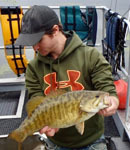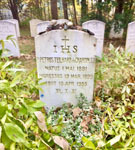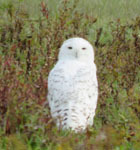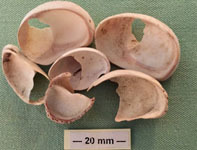Hudson River Almanac 10/26/18 - 11/02/18
The New York State Department of Environmental Conservation sent this bulletin on 11/09/2018 02:00 PM EST |
| DEC Delivers - Information to keep you connected and informed from the NYS Department of Environmental Conservation |
| Share or view as a web page || Update preferences or unsubscribe |
|
Compiled by Tom Lake, Hudson River Estuary Program Consulting NaturalistOverviewOur Hudson Valley spring always proceeds from south to north, from sea level to a mile high. Conversely, winter drops down from the north with ice and snow and with winter songbirds and waterfowl as the vanguard. This week, we noted the arrival of winter finches and ducks in the Mid-Hudson Valley as the High Peaks of the Adirondacks began to accumulate snow. Highlight of the Week10/26 – Red Hook, HRM 96.5: Some tales are timeless, like the coyote and the crow. We had an amazing experience recently as we passed a harvested cornfield off Route 9. At first, we thought we were watching two wild turkeys. But, when we focused on the animals, we realized it was a coyote in the throes of bringing down a crow. Our last look was the crow firmly in the coyote’s jaws and making a last, desperate attempt at escape with one large black wing stretched skyward. [In Native American lore, coyote and crow are wise, cunning, and their competition maintains the balance of the natural order. For an excellent look at this relationship, see Nick Young’s and Jena Wilson’s book Coyote and Crow, (2013). Tom Lake] Natural History Entries
10/27 – Furnace Woods, HRM 38.5: An autumn ritual for me is the “Filling of the Feeders Festival” for the winter birds, and then taking an hour to see what species show up first. Not surprisingly, black-capped chickadees were first, followed almost immediately by tufted titmice. Then came house finches, and to my delight, a couple of purple finches. Soon, there were white-breasted nuthatches, and another surprise, a red-breasted nuthatch. At the close of the hour, I had counted ten species. A hermit thrush and a brown creeper visited but did not feed. At the very last minute, dark-eyed juncos showed under the feeders taking advantage of the spillage, and a monarch butterfly fluttered past. I cannot recall ever seeing those last two at the same time. 10/27 – Ulster County, HRM 85: I have had at least six evening grosbeaks, four males and two females, at my feeders for a few days. These true winter finches had not been at my feeders since 2011. 10/27 – Buchanan, HRM 42: We had a newcomer to our yard today, a beautiful male rose-breasted grosbeak. This is the first time we’d seen one this year. Its striking black-and-white back, vivid red marking on its white breast, and stout conical finch bill, made it easy to identify. It certainly was a colorful addition to our backyard and we were glad it stopped by before heading south. 10/28 – Minerva, HRM 284: We had some slushy snow yesterday; today there were just flurries. We have had a few frosty mornings but no serious freezes yet. 10/28 – Coxsackie, HRM 124: On an overcast day with occasional drizzle, I found an interesting mix of mid-fall birds at the Coxsackie Grasslands. Among the ducks was a hen bufflehead and six mallards including a mallard x black duck hybrid. Included in the raptors was a northern harrier, a bald eagle, and a northern red-tailed hawk (Buteo jamaicensis abieticola), a sub-species of our far more common eastern red-tailed hawk (B.j. borealis). I counted six species of sparrows as well, including white-crowned, white-throated, vesper, Savannah (many), song, and swamp sparrow. 10/28 – Town of Warwick, HRM 41: I visited Liberty Marsh today, part of the U.S. Fish and Wildlife Service’s Wallkill River National Wildlife Refuge complex. While there, I spotted a cattle egret, a “state bird” for me, although I have seen many of them in Florida. 10/28 – Bedford, HRM 35: Turkey vultures accounted for two-thirds of the migrants today at the Bedford Audubon Chestnut Ridge Hawkwatch. Sharp-shinned hawk (31) was high count among the 71 raptors. Red-shouldered hawks (16) made a good showing as well. Non-raptor observations included 62 American robins and a common loon. 10/28 – Rockland County, HRM 31: It was a cold, cold day at the Hook Mountain Hawkwatch and almost raptor-free. We counted just five across five hours with two sharp-shinned hawks on top. Of the other non-raptor migrants, 32 were turkey vultures and two were black vultures. Non-raptor observations included the yellow-billed cuckoo we first saw three days ago.
[As far as we can tell, the previous sighting of a Mandarin duck in New York City was by Leslie Day in 2010 at the 79th Street Boat Basin in Manhattan. 10/29 – Danskammer Point, HRM 66.5: There is an adage about estuaries that no one moment will ever occur again in exactly the same way, that every minute of every hour is unique. Given all of the factors that go into an estuarine "moment," this seems mathematically logical. On this day, thirty-six years ago, a moment occurred that, as far as I know, has never been repeated. I was drift-fishing in the ebb current of the warm-water outflow from the Danskammer Point Power Generating Facility in Orange County when a large school of small herring erupted from the water. Something was chasing them. At almost the same time, a dozen foot-long silvery flashes appeared and one of them hit my lure. The fish was an acrobat, leaping from the water, swapping ends, before splashing back. The hook pulled free, but then another one struck. This one leaped boat side and landed on the gunwale, teetering there for a few seconds before flopping into the boat. The rest of them dispersed, never to be seen again, and I've been looking for 35 years.
10/29– Bedford, HRM 35: It was a good day for turkey vultures (91) at the Bedford Audubon Chestnut Ridge Hawkwatch; they represented 72% of all migrants. Sharp-shinned hawk (10) was high count among raptors. Northern harriers (8) also made a good showing. Non-raptor observations included 160 American robins and 81 cedar waxwings. 10/29 – Rockland County, HRM 31: Four of the 14 raptors we counted at the Hook Mountain Hawkwatch today were immature red-shouldered hawks. The first one flew low from the northeast in mid-morning, investigated our owl decoy, then gained elevation before dropping into a valley. The second came to the watch near midday, turned around, flew north, gained a lot of height, and then flew south. A third juvenile red-shouldered arrived from the east, came through the trees, and flew ten feet over our heads. Thrilling! 10/30 – Rockland County, HRM 31: We had extremely clear visibility all day at the Hook Mountain Hawkwatch – as good as it gets here. A golden eagle came up from the east side of the mountain scaring a few vultures. The eagle seemed to be in less-than-pristine shape with several very ruffled or a bit torn flight feathers. It quickly sped off west. In a scope view, it was an adult by plumage, but the gold nape was not that obvious. Getting a true count of red-tailed hawks is always a bit challenging when so many were clearly on the move. A conservative count today was 21 birds. High count among the 103 raptors sighted was sharp-shinned hawk with 45. Red-shouldered hawks (25) also made a good showing. Non-raptor observations included purple finches (30+), red-winged blackbirds (150+), common grackles (800+), as well as brant, and common ravens.
Today, we left a small brick of peat from Loch Ness in Scotland, purported home of the cryptic Nessiteras rhombopteryx. Our second offering was a small fossilized colony of brachiopods from New York’s Devonian period, c. 400 million years ago, when New York was covered by water. Both were remembrances of the scientist in de Chardin. He spent much of his life searching for common ground between religious dogma and natural history, reconciling his faith with modern science. That made him a truly unique individual in his time. (Photo of Teilard de Chardin courtesy of Tom Lake) [Peat is the partially decayed remains of vegetation locked in water-logged Scottish moors, an oxygen-free environment that prevents decomposition. Peatland moors cover more than 20% of Scotland. For millennia, peat-cutting has been a social event when families gather on the moors to harvest the fuel that will provide warmth and a means to cook their food. Tom Lake] [This Halloween tradition, in its tenth year, is a low-profile, unofficial version of such better-known examples such as “roses and cognac” at Edgar Allan Poe’s crypt in Baltimore or “flowers and poetry” at Jim Morrison’s grave in Paris. In the instance of de Chardin, it is very simply a means of remembering a kindred soul. Tom Lake]
[While snowy owl incursions are typically “dead of winter” events, modest numbers can show up anytime from late fall through early spring. In 2017, our first snowy owl appeared on 11/15. Tom Lake] 10/31 – Kowawese, HRM 59: A 30 mph south wind was gusting up through the Hudson Highlands, building breakers that formed and crested a hundred yards off shore. Despite the conditions, we were committed to hauling our seine. Pulling the outboard end, I felt an icy blast every time a wave slapped my back as I focused on staying upright. Looking for seaward migrants, we found none. The expected, however, were there in the swash, a high energy zone where white perch in numbers (105-190 millimeters (mm)) foraged on prey swept up in the turbulence. The river was 53 degrees Fahrenheit (F). [Note: one inch = 25.4 millimeters (mm)] 10/31 – Bedford, HRM 35: Most of the flight at the Bedford Audubon Chestnut Ridge Hawkwatch today – 107 migrants of eight species – was to the west at heights viewable with the naked eye. High count went to turkey vultures (28), with red-tailed hawk (28) and sharp-shinned hawk (27) high among raptors. Non-raptor observations included 887 American robins, 114 cedar waxwings, and 136 common grackles. 10/31 – Rockland County, HRM 31: It was a great Halloween day at the Hook Mountain Hawkwatch! I counted 92 raptors, 66 of which were sharp-shinned hawks. Northern harriers and red-shouldered hawks (six each) made a good showing as did bald eagles (4). 10/31 – Yonkers, HRM 18: Third-grade students from the Fieldston School in the Bronx came to the Sarah Lawrence College Center for the Urban River at Beczak to help us seine the river. Despite falling water temperatures, we did quite well. In the morning, we learned about the estuary and the important role of marshes. At high tide, 23 students set forth to the Beczak Marsh where we caught Atlantic silversides, mummichogs, and three-dozen young-of-year striped bass. Balancing out the catch were blue crabs and shore shrimp. 11/1– Bedford, HRM 35: Thirty of the 51 migrants at the Bedford Audubon Chestnut Ridge Hawkwatch today were turkey vultures. Most of the flight was to the west or southwest at variable heights. Non-raptor observations included 81 cedar waxwings and a monarch butterfly. 11/1 – Rockland County, HRM 31: It was a very slow day for raptor movement at the Hook Mountain Hawkwatch. Of the dozen raptors, half were sharp-shinned hawks. Turkey vultures put on a choreographed ballet, circling the summit, flying over the dip to the ridgeline west of us, returning to the Hook, and then back to the ridge again. Many yellow-rumped warblers were seen on the trails up the mountain and at the summit. 11/1 – Palisades, HRM 23: I left my office at Lamont-Doherty Earth Observatory in the warm dusk of early evening. I spotted two small bats actively hunting insects at tree-top level in the parking lot. I soon spotted a half-dozen more flying low across the road below a street light. I have not seen so many bats at once in years. It was nice to see them. While I am far from an expert in identifying bats, given the approximate size of their wingspans, these were most likely little brown bats, also known as little brown myotis (Myotis lucifugus).
Some things we know: The slipper shells cannot be fossils; these are recently-alive shellfish. According to the literature, they cannot live in the river off New Baltimore. It has been proposed that they could be a dump from a seashell collection or even just the aftermath of a visit to the seashore. Other ideas include transport and shedding from commercial vessels or pleasure craft, falling off scientific gear used in saltwater, or drops from the exoskeleton of horseshoe crabs used for blue crab bait. Finally, perhaps they just violated the literature (not likely). (Photo of common slipper shell courtesy of Tom Lake) [The common slipper shell (Crepidula fornicata) is a sedentary filter-feeder sea snail or marine gastropod mollusk. Along with C. Plana and C. Convexa, they are native to the east coast of North America ranging from Canada south to Florida. All three species are strictly saltwater mollusks with no documented affinity for low salinity or freshwater. Tom Lake] 11/2 – Buchanan, HRM 42: While leaving a parking lot, we spotted two wild turkeys coming out of the nearby woods. Then, to our surprise, walking in a line, came 13 more. They slowly strolled across the parking lot and began to climb a hill on the other side. They seemed so organized with designated “crossing guards.” 11/2– Bedford, HRM 35: On a slow day, we counted seven migrants of four species at the Bedford Audubon Chestnut Ridge Hawkwatch. Most of the flight was to the west at heights easily seen. Sharp-shinned hawk (2) was high count among raptors and we added a Cooper’s hawk and a merlin as well. Non-raptor observations included a red-winged blackbird. Autumn 2018 Natural History ProgramsSaturday, November 10 Monday, December 3 8:45 AM to 4:00 PM. Free Trees for Streamside Planting Hudson River Miles DEC's Smartphone app for iPhone and Android is now available at: New York Fishing, Hunting & Wildlife App. Adventure NYUnder Governor Cuomo's Adventure NY initiative, DEC is making strategic investments to expand access to healthy, active outdoor recreation, connect more New Yorkers and visitors to nature and the outdoors, protect natural resources, and boost local economies. This initiative will support the completion of more than 75 projects over the next three years, ranging from improvements to youth camps and environmental education centers to new boat launches, duck blinds, and hiking trails. Read more about the Adventure NY initiative. For more information on planning an outdoor adventure in New York State, visit DEC's website at http://www.dec.ny.gov/outdoor. |

 Hudson River Almanac
Hudson River Almanac 10/26 – Mohawk River, HRM 157: A nine-person team from DEC Region 4 Fisheries, as well as volunteers from the Van Hornesville fish hatchery, NY Natural Heritage, NYS Office of Parks, and the NYS Museum, offered our contribution to the 16th annual Day in the Life of the Hudson and Harbor. We started by electro-shocking locations on the Mohawk and upper Hudson rivers on 10/15 that featured a trophy-size smallmouth bass captured, photographed, and released, just above Lock E7 on the Mohawk River. Almost 300 fish comprising 27 species were captured in just over two hours on the eastern Mohawk and upper Hudson River. Many of the hardier fishes were held over to the next day when they enthralled some 561 students, grades 1-12, from 13 schools eager to learn about the rivers and their aquatic life. (Photo of smallmouth bass courtesy of Scott Wells)
10/26 – Mohawk River, HRM 157: A nine-person team from DEC Region 4 Fisheries, as well as volunteers from the Van Hornesville fish hatchery, NY Natural Heritage, NYS Office of Parks, and the NYS Museum, offered our contribution to the 16th annual Day in the Life of the Hudson and Harbor. We started by electro-shocking locations on the Mohawk and upper Hudson rivers on 10/15 that featured a trophy-size smallmouth bass captured, photographed, and released, just above Lock E7 on the Mohawk River. Almost 300 fish comprising 27 species were captured in just over two hours on the eastern Mohawk and upper Hudson River. Many of the hardier fishes were held over to the next day when they enthralled some 561 students, grades 1-12, from 13 schools eager to learn about the rivers and their aquatic life. (Photo of smallmouth bass courtesy of Scott Wells) 10/28 – Manhattan, HRM 5: On a crescent-shaped pond in the southeast corner of Central Park, a spectacularly colorful duck was floating on the surface with an air of majesty. It was a male Mandarin duck (Aix galericulata), native to east Asia, and totally out of place in New York City. The duck was first spotted in Central Park on 10/10 but then disappeared. Two weeks later, it was sighted at the 79th Street Boat Basin. Then, it was back here today still wearing the same band on its right leg noted from earlier sightings. Mandarin ducks have been imported widely to Europe and the Americas, and those found in the wild are almost always escapees from captivity. (Photo of Mandarin duck courtesy of Clayton Surratt)
10/28 – Manhattan, HRM 5: On a crescent-shaped pond in the southeast corner of Central Park, a spectacularly colorful duck was floating on the surface with an air of majesty. It was a male Mandarin duck (Aix galericulata), native to east Asia, and totally out of place in New York City. The duck was first spotted in Central Park on 10/10 but then disappeared. Two weeks later, it was sighted at the 79th Street Boat Basin. Then, it was back here today still wearing the same band on its right leg noted from earlier sightings. Mandarin ducks have been imported widely to Europe and the Americas, and those found in the wild are almost always escapees from captivity. (Photo of Mandarin duck courtesy of Clayton Surratt) [This was a school of ladyfish (Elops saurus), a tropical relative of the tarpon. Tropical marine strays, aided by the Gulf Stream and warming inshore waters of the Mid-Atlantic, are not uncommon in the lower estuary. We see jacks fairly regularly, and on very rare occasions, we catch grouper, snapper, bonefish, and small barracuda. Ladyfish, however, have managed to remain an elusive memory. Tom Lake] (Photo of ladyfish courtesy of Tom Lake)
[This was a school of ladyfish (Elops saurus), a tropical relative of the tarpon. Tropical marine strays, aided by the Gulf Stream and warming inshore waters of the Mid-Atlantic, are not uncommon in the lower estuary. We see jacks fairly regularly, and on very rare occasions, we catch grouper, snapper, bonefish, and small barracuda. Ladyfish, however, have managed to remain an elusive memory. Tom Lake] (Photo of ladyfish courtesy of Tom Lake) 10/31 – Hyde Park, HRM 80: All Hallows Eve. For many fans of the season, Halloween is a time to dress up scary and go in search of tricks-or-treats. We have our own tradition: An annual pilgrimage to the grave of Pierre Teilhard de Chardin, a Jesuit theologian, anthropologist, paleontologist, and renowned naturalist who died in 1955 and was buried on the grounds of the Culinary Institute. Amidst a hundred or more identical gravestones, de Chardin’s is easy to find. There are frequently flowers and always a collection of items – tokens of natural history – left by those paying homage.
10/31 – Hyde Park, HRM 80: All Hallows Eve. For many fans of the season, Halloween is a time to dress up scary and go in search of tricks-or-treats. We have our own tradition: An annual pilgrimage to the grave of Pierre Teilhard de Chardin, a Jesuit theologian, anthropologist, paleontologist, and renowned naturalist who died in 1955 and was buried on the grounds of the Culinary Institute. Amidst a hundred or more identical gravestones, de Chardin’s is easy to find. There are frequently flowers and always a collection of items – tokens of natural history – left by those paying homage. 10/31 – Dutchess County, HRM 77: I came upon a snowy owl, our first of the season, perched on a fence on Salt Point Turnpike in Clinton Corners. It appeared to be either an adult female or a first-year male. (Photo of snowy owl courtesy of Barbara Mansell)
10/31 – Dutchess County, HRM 77: I came upon a snowy owl, our first of the season, perched on a fence on Salt Point Turnpike in Clinton Corners. It appeared to be either an adult female or a first-year male. (Photo of snowy owl courtesy of Barbara Mansell) 11/2 – New Baltimore, HRM 131.5: Kelly Halloran found more common slipper shells in a cove at the same beach where they were previously discovered (see 9/28). This cove is immediately south of Mrs. Sherman's Beach in New Baltimore. We are attempting to find a plausible theory as to how they came to be there. Unfortunately, it may turn out to be a very boring conclusion.
11/2 – New Baltimore, HRM 131.5: Kelly Halloran found more common slipper shells in a cove at the same beach where they were previously discovered (see 9/28). This cove is immediately south of Mrs. Sherman's Beach in New Baltimore. We are attempting to find a plausible theory as to how they came to be there. Unfortunately, it may turn out to be a very boring conclusion.